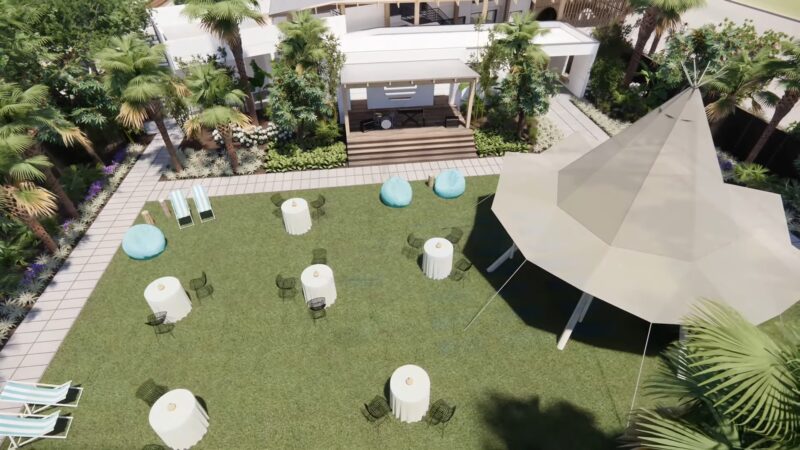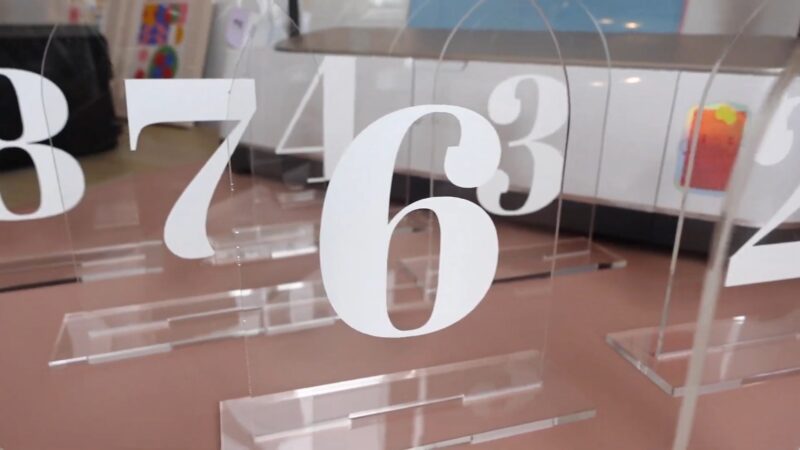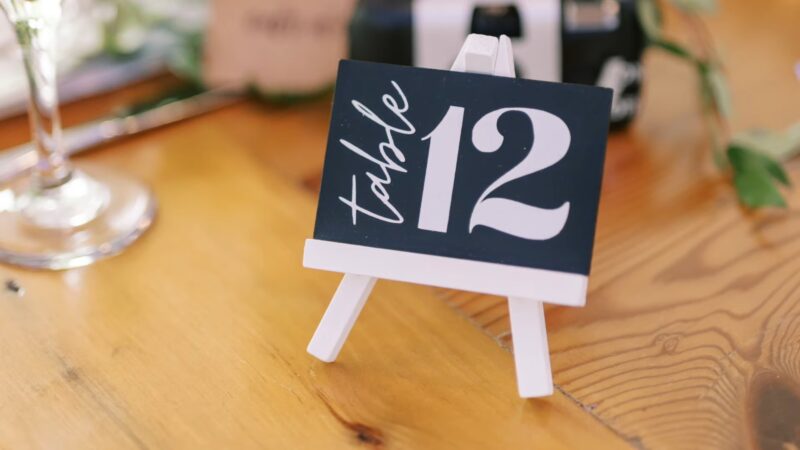When it comes to organizing an event, the devil is in the details. One of the most nuanced yet impactful aspects is the arrangement of seating, often materialized in the form of assigning table numbers.
This seemingly small task can significantly influence the event’s flow, guest interaction, and overall atmosphere. It’s an art and science that, when done right, can elevate the guest experience and streamline event operations.
A well-considered layout ensures guests are seated where they can enjoy the company, view, and festivities without hindrance. It also aids service staff in providing prompt and seamless service.
1. Be Aware of the Venue Layout

When organizing an event, one of the first and most crucial steps is to thoroughly understand the physical environment of your venue. Start by assessing the venue’s floor plan. Identify key areas: entrances, exits, restrooms, and stages.
Each table’s placement should consider these elements, optimizing guest interaction and service efficiency. Visualize the event from the guests’ perspective, ensuring each seat offers a pleasant view and easy access to amenities.
Consider the acoustics and lighting in different areas of the venue. The ambiance of the event can be greatly affected by these elements, and thus they should influence table placement. Ensure that each guest can both see and hear presentations or entertainment without strain.
Ensure the Guest Flow
Guest circulation is an art, guiding them smoothly from one area to another. It’s essential to anticipate high-traffic areas and bottlenecks. Your layout should facilitate an easy flow, allowing attendees to move freely between tables, to the catering area, and facilities like restrooms.
Consider visual cues or signage that lead guests to their designated areas without confusion.
2. Adjust According to the Guest List
The composition of your guest list significantly influences table assignments. Understanding relationships, group dynamics, and individual needs is essential. Grouping friends, family, or colleagues ensures a comfortable and enjoyable environment.
Be mindful of special considerations, such as providing easy access for elderly or disabled guests or accommodating dietary restrictions.
Make it More Engaging for People
A thoughtful seating plan contributes to the atmosphere and interaction at your event. Aim to place guests in positions where they can engage in meaningful conversations and enjoy the company of their tablemates.
Consider the personalities and interests of your attendees, and try to create synergies that might spark new friendships or business connections. Additional details like international guests or having an Interfaith Wedding should also be taken into consideration.
3. Choose the Right Theme and Decor
Your seating arrangement should complement the overall theme and decor of the event. Consistency in style, color, and decoration creates a cohesive and immersive environment. Align your table arrangement with the event’s theme, whether elegant, casual, or thematic.
The placement, shape, and decoration of tables can all serve to enhance this theme. Lighting plays a crucial role in setting the mood. Ensure that it complements the decor and that no guest is left in the dark or under harsh light.
Decorative elements should be visible and appreciated from all angles. Avoid blocking views or creating cluttered spaces.
How to Improve Ambiance?
The ambiance of an event is significantly influenced by its visual appeal. Consider the placement of tables with decorative elements, lighting, and focal points.
Each seat should offer a pleasant view, and the overall layout should contribute to the aesthetic and mood you aim to set.
4. Consider Special Requirements

Every guest deserves to feel comfortable and included. This means considering physical accessibility, dietary restrictions, and any other personal needs when planning your seating chart.
Review the guest list for any noted special requirements and plan accordingly. This might involve coordinating with the catering team to handle dietary needs or adjusting the layout to ensure mobility for all guests.
Effective communication with attendees before the event can help identify these needs and allow for adequate preparation.
Accommodate Everyone
Accommodating special requirements isn’t just about adhering to regulations; it’s about showing care and consideration for all attendees.
Whether it’s providing space for wheelchairs, ensuring that dietary needs are met, or making sure that families are seated together, these details can make a significant difference in the guest experience.
5. Efficient Logistics is Crucial
Assigning spots is more than just putting names to tables; it involves a logistical balance to ensure that the process is efficient and effective. Consider the available tools and how they can be integrated into your planning process.
Look for features like drag-and-drop seating charts, guest list import capabilities, and options for printing or sharing the final layout digitally. Clear, visible table numbers or names, along with an intuitive layout, will assist guests in finding their seats quickly and easily.
Streamline the Process
There are numerous digital solutions available to assist in seating arrangement planning. These tools can provide visual layouts, manage guest lists, and even allow for easy adjustments as needed. Embracing these technologies can save time, prevent confusion, and contribute to a smooth-running event.
6. Timing and Communication

The timing of when you reveal the seating arrangements to your guests can influence their anticipation and preparation for the event. Releasing the information too early might lead to confusion if changes occur, while too late might cause anxiety or inconvenience.
Finding the right balance is key. Plan to release the seating chart close enough to the event date to minimize changes, yet early enough to allow guests to prepare.
Consider any cultural or personal preferences that might influence how this information is received and adapt your communication method accordingly.
Provide Clear Information
Effective communication of seating arrangements is crucial. Whether it’s through digital announcements, printed cards, or signage at the event, ensuring that each guest is informed about their seating in a timely and clear manner will minimize confusion and enhance their experience.
Flexibility and Last-Minute Changes
Despite the best-laid plans, last-minute changes are almost inevitable. Being prepared to adapt quickly and efficiently is crucial. Keep a flexible mindset and prepare for various scenarios.
Ensure that your seating plan allows for some adjustments without major disruptions. Quick, calm, and effective decision-making in these situations will maintain the event’s flow and ensure that all guests remain comfortable and happy.
Handle Unexpected Situations
The ability to handle changes gracefully can significantly affect the event’s success. Having a plan in place for common last-minute adjustments will allow you to respond swiftly and keep everything running smoothly.
FAQs

What is the best size for table numbers?
The best size for table numbers depends on the size and layout of your tables, as well as the visibility and readability of the numbers. A general rule of thumb is to choose table numbers that are at least 4×6 inches, but you can adjust the size according to your preference and style.
What can I use instead of table numbers?
You can use anything that suits your wedding theme and personality instead of table numbers. For example, you can use names of places, songs, movies, books, flowers, animals, or colors. You can also use pictures, symbols, or objects that represent something meaningful to you and your partner.
How do you list names on a seating chart?
There are different ways to list names on a seating chart, but the most common one is to list them alphabetically by last name, followed by the table number or name. You can also group the names by table, or by category (such as family, friends, coworkers, etc.). Make sure the names are clear and easy to read.
Do place cards need table numbers?
Place cards need table numbers if you have assigned seats for your guests. This way, they can easily find their table and seat without confusion. If you only have assigned tables, but not seats, you can skip the table number on the place cards and just use the seating chart.
Last Words
Assigning table numbers is a task that, while seemingly simple, plays a critical role in the success of any event. From understanding your venue and knowing your guest list to accommodating special requirements and being prepared for last-minute changes, each aspect contributes to creating a seamless and enjoyable experience for all attendees.
